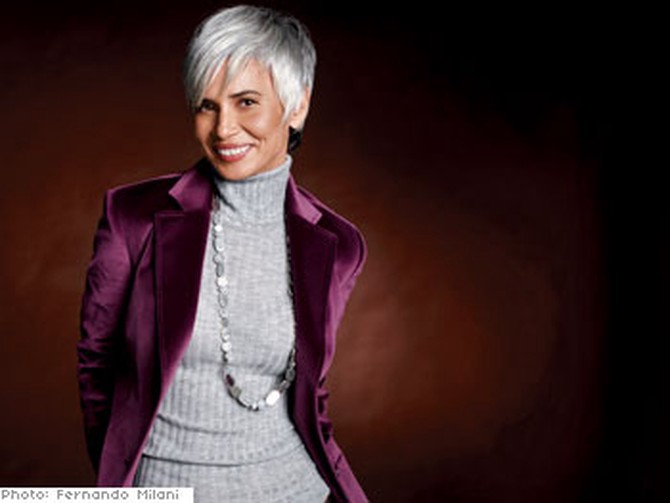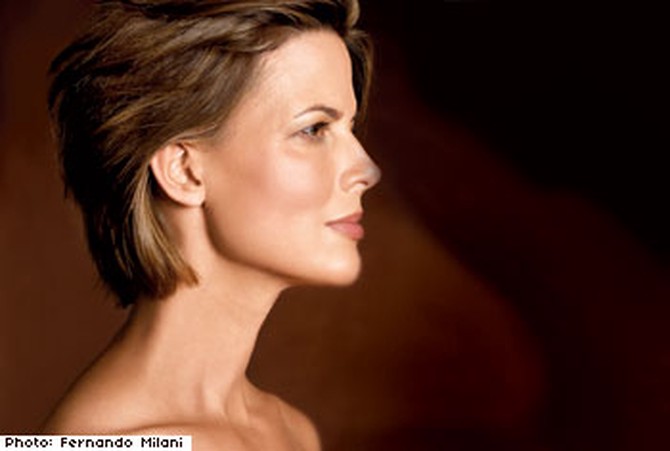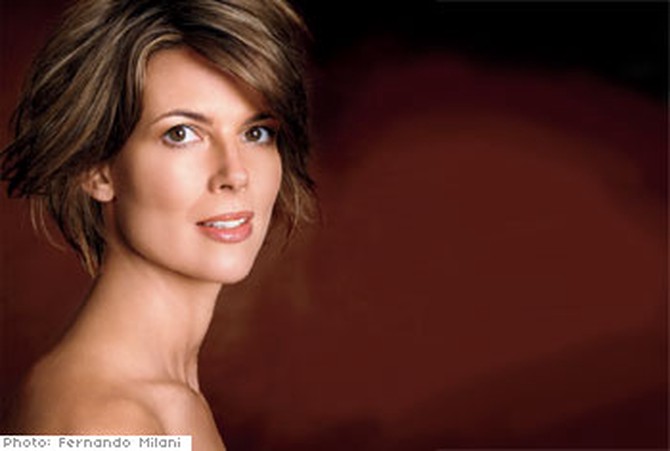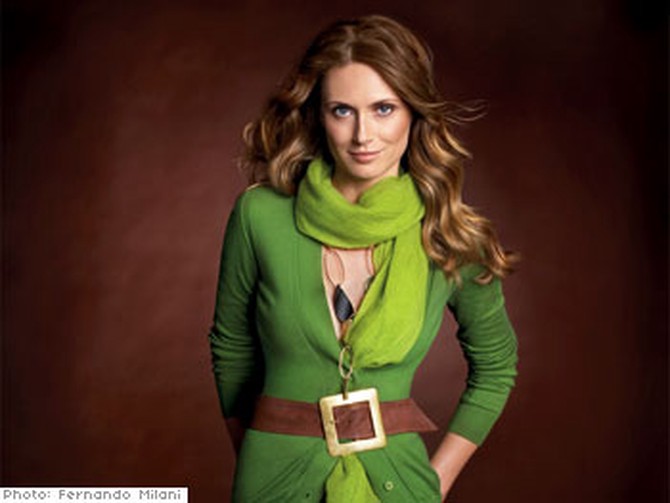Feel Better About Your Neck

Wear necklines that romance the throat
Camouflage loses its usefulness when people start suspecting that you have something to hide. "Turtlenecks are incredible, but we can't wear them all the time," says TV fashion reporter Christine Schwab, author of The Grown-Up Girl's Guide to Style. "The point is to frame the neck, not cover it up." This can be as simple as turning up the collar of a tailored shirt or jacket, or shopping for tops with attractive details that conceal the throat partially but don't throttle it.
The right neckline is crucial: Deep V's or low-cut tank tops will make the neck look longer, Schwab says, but they also display lots of possibly sun-damaged skin. Consider higher-cut versions as well, and go in for strategic layering—V-necks over shirts, tank tops under shirts, turtlenecks with anything (find the soft, easy-fitting kind that don't constrict the neck). You should test-drive any top by twisting and turning your head in a three-way mirror: Often the neck looks fine until it moves, making the skin scrunch up. You don't want to emphasize those creases with a style that's too tight or revealing.
Camouflage loses its usefulness when people start suspecting that you have something to hide. "Turtlenecks are incredible, but we can't wear them all the time," says TV fashion reporter Christine Schwab, author of The Grown-Up Girl's Guide to Style. "The point is to frame the neck, not cover it up." This can be as simple as turning up the collar of a tailored shirt or jacket, or shopping for tops with attractive details that conceal the throat partially but don't throttle it.
The right neckline is crucial: Deep V's or low-cut tank tops will make the neck look longer, Schwab says, but they also display lots of possibly sun-damaged skin. Consider higher-cut versions as well, and go in for strategic layering—V-necks over shirts, tank tops under shirts, turtlenecks with anything (find the soft, easy-fitting kind that don't constrict the neck). You should test-drive any top by twisting and turning your head in a three-way mirror: Often the neck looks fine until it moves, making the skin scrunch up. You don't want to emphasize those creases with a style that's too tight or revealing.

Beauty routines for neck maintenance
Our faces shouldn't hog all the products. Let's do something for our highly susceptible (but often neglected) necks. The skin in this zone is thin and sensitive, explains Susan Taylor, MD, a dermatologist in Philadelphia. "That means cleansing gently—no scrubbing—and using the same moisturizers as under your eyes."
It also means including the neck when you apply your daily sunscreen. Foundation isn't necessary, though, unless you have sun-damage spots (best concealed, according to makeup artist and cosmetics entrepreneur Trish McEvoy, with a pressed mineral-powder base—cream or liquid is too heavy). To escape the jarring vision of a face that's a shade or two lighter than the neck supporting it, McEvoy suggests doing a visual check with a digital self-portrait (even more objective than a mirror).
How about more drastic remedies? Alan Matarasso, MD, a plastic surgeon in New York City, tells us that necklifts tighten sags but won't improve crepey texture. For that you could try nonsurgical treatments like lasers, but they don't last and aren't consistently successful. Learning to live with your natural-born neck is, we think, a cheaper and less risky proposition.
Our faces shouldn't hog all the products. Let's do something for our highly susceptible (but often neglected) necks. The skin in this zone is thin and sensitive, explains Susan Taylor, MD, a dermatologist in Philadelphia. "That means cleansing gently—no scrubbing—and using the same moisturizers as under your eyes."
It also means including the neck when you apply your daily sunscreen. Foundation isn't necessary, though, unless you have sun-damage spots (best concealed, according to makeup artist and cosmetics entrepreneur Trish McEvoy, with a pressed mineral-powder base—cream or liquid is too heavy). To escape the jarring vision of a face that's a shade or two lighter than the neck supporting it, McEvoy suggests doing a visual check with a digital self-portrait (even more objective than a mirror).
How about more drastic remedies? Alan Matarasso, MD, a plastic surgeon in New York City, tells us that necklifts tighten sags but won't improve crepey texture. For that you could try nonsurgical treatments like lasers, but they don't last and aren't consistently successful. Learning to live with your natural-born neck is, we think, a cheaper and less risky proposition.

Get a kinder haircut
Divert attention up and away from a slack neck with a well-defined bob that hits right below the chin, says New York City stylist and salon owner John Barrett. Longer hair draws the eye downward, spotlighting the neck rather than minimizing it. "And a style that has movement also helps focus attention onto the hair," says Dickey, a New York City stylist who did the hair for this story.
Divert attention up and away from a slack neck with a well-defined bob that hits right below the chin, says New York City stylist and salon owner John Barrett. Longer hair draws the eye downward, spotlighting the neck rather than minimizing it. "And a style that has movement also helps focus attention onto the hair," says Dickey, a New York City stylist who did the hair for this story.

Make friends with the scarf
Warmth is hardly the only rationale for wearing scarves: They're an absolute godsend for those with neck issues, surrounding the problematic area with color and texture—and doing it with such verve that even basic clothes seem more sophisticated. Schwab swears that she never goes out without one, switching from thin wool and silk in winter to gauze and linen when summer comes. Her advice:
Bargainista alert: Schwab likes to buy luxury yard goods from a fabric store and have them made up into scarves by a local seamstress (or do it yourself if you sew).
Warmth is hardly the only rationale for wearing scarves: They're an absolute godsend for those with neck issues, surrounding the problematic area with color and texture—and doing it with such verve that even basic clothes seem more sophisticated. Schwab swears that she never goes out without one, switching from thin wool and silk in winter to gauze and linen when summer comes. Her advice:
- Pick solids or understated prints in a muted palette; brights can be overwhelming near the face.
- Stick to low-bulk fabrics that can be wrapped or tied easily.
- Avoid tightly wound scarves or self-conscious arrangements: "They should look offhand, as if you just threw them on," Schwab says.
- A silk or chiffon neck square is an attractive ploy for filling in the neckline of a shirt or jacket; a gently draped oblong sets up a vertical line that makes the torso seem leaner.
Bargainista alert: Schwab likes to buy luxury yard goods from a fabric store and have them made up into scarves by a local seamstress (or do it yourself if you sew).

Follow the jewelry rules
Bold but not heavy is the idea here—unless you want to resemble a Masterpiece Theatre dowager, all jowls and jeweled chokers. "Massive necklaces can make a big statement," says Schwab. "But they can also create wrinkles by pinching the skin." Look for comfortably lightweight pieces that are large enough to cover the chest—you can even layer on several for a more intense effect. Collarbone length is ideal because it establishes decorative frame for the neck. (Tight chokers, however, are problematic: They press the flesh, causing creases when you turn your head.) Vivid earrings in unusual shapes can deflect attention from your neck (chic, eye-catching glasses do the same), but again, beware anything weighty—if the ponderous silver hoops you found in Puerto Vallarta are pulling down your lobes, everything will start to look droopy. It takes discipline to handle jewelry well. Schwab allows herself a single focal point: either an elaborate necklace or imaginative earrings, not both—or, if she wants to shift the emphasis altogether, an armful of stacked bracelets.
Bold but not heavy is the idea here—unless you want to resemble a Masterpiece Theatre dowager, all jowls and jeweled chokers. "Massive necklaces can make a big statement," says Schwab. "But they can also create wrinkles by pinching the skin." Look for comfortably lightweight pieces that are large enough to cover the chest—you can even layer on several for a more intense effect. Collarbone length is ideal because it establishes decorative frame for the neck. (Tight chokers, however, are problematic: They press the flesh, causing creases when you turn your head.) Vivid earrings in unusual shapes can deflect attention from your neck (chic, eye-catching glasses do the same), but again, beware anything weighty—if the ponderous silver hoops you found in Puerto Vallarta are pulling down your lobes, everything will start to look droopy. It takes discipline to handle jewelry well. Schwab allows herself a single focal point: either an elaborate necklace or imaginative earrings, not both—or, if she wants to shift the emphasis altogether, an armful of stacked bracelets.
From the November 2007 issue of O, The Oprah Magazine

